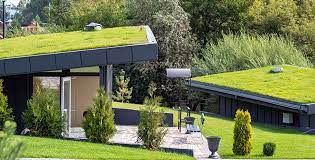Introduction to Green Roofs
Green roofs, also known as living roofs or eco-roofs, are vegetative systems installed atop buildings to provide a range of environmental, economic, and social benefits. They consist of a waterproofing membrane, drainage layer, growing medium, and vegetation. Green roofs can be either extensive, featuring low-maintenance plantings, or intensive, with more diverse vegetation and recreational spaces.
Types of Green Roofs
Extensive Green Roofs
Extensive green roofs are characterized by their shallow soil depth and low-maintenance vegetation, such as sedum and other drought-tolerant plants. They are lightweight and well-suited for retrofitting existing buildings or structures with limited load-bearing capacity.
Intensive Green Roofs
Intensive green roofs have deeper soil profiles and support a wider variety of plant species, including shrubs, trees, and even small gardens or recreational areas. They require more maintenance and irrigation but offer greater aesthetic and recreational benefits.
Importance of Green Roof Maintenance
Maintaining a green roof is essential for preserving its ecological benefits and structural integrity while minimizing the risk of damage and leaks. Regular maintenance helps ensure that the vegetation remains healthy, the drainage system functions properly, and the roof substrate retains its integrity over time.
Seasonal Maintenance Tasks
Spring Maintenance
In spring, green roofs require inspection for winter damage, pruning of overgrown vegetation, and fertilization to promote new growth.
Summer Maintenance
During the summer months, regular watering and monitoring of plant health are crucial to prevent drought stress and maintain optimal growing conditions.
Fall Maintenance
In fall, green roofs should be prepared for winter by removing fallen leaves, inspecting drainage systems, and protecting vulnerable plants from frost damage.
Winter Maintenance
Winter maintenance focuses on preventing ice dams, clearing snow accumulation, and ensuring that drainage outlets remain clear and functional.
Regular Maintenance Practices
Weeding and Pruning
Regular weeding and pruning help control plant growth and prevent invasive species from taking over the green roof ecosystem.
Irrigation Management
Proper irrigation management involves monitoring soil moisture levels and adjusting watering schedules to meet the needs of the plants while conserving water resources.
Fertilization and Soil Testing
Periodic soil testing and fertilization ensure that the growing medium remains nutrient-rich and supports healthy plant growth throughout the year.
Eco-Friendly Maintenance Techniques
Using Organic Fertilizers
Organic fertilizers promote soil health and microbial activity, improving nutrient uptake and reducing the risk of nutrient runoff into surrounding waterways.
Implementing Integrated Pest Management
Integrated pest management techniques minimize the use of chemical pesticides by promoting natural predators and employing cultural and mechanical controls to manage pest populations.
Conserving Water Resources
Water conservation measures, such as installing rainwater harvesting systems and using drought-tolerant plants, help reduce the environmental impact of green roof irrigation.
Professional Maintenance Services
Hiring a Green Roof Maintenance Contractor
Professional maintenance contractors specialize in green roof care and can provide comprehensive services, including inspections, repairs, and seasonal maintenance tasks.
Frequency of Professional Inspections
The frequency of professional inspections depends on factors such as the size and complexity of the green roof, local climate conditions, and the level of maintenance performed by building owners or occupants.
Common Maintenance Challenges
Weed and Pest Infestations
Weeds and pests can pose challenges to green roof maintenance, requiring proactive management strategies to prevent infestations and minimize damage.
Drainage Issues
Poor drainage can lead to waterlogged soil, root rot, and structural damage, necessitating regular inspection and maintenance of drainage systems.
Plant Health Concerns
Monitoring plant health is essential for identifying signs of stress, disease, or nutrient deficiencies and implementing corrective measures as needed.
DIY Maintenance Tips
Monitoring Plant Health
Regular visual inspections of plant health can help identify issues early and prevent them from escalating into more significant problems.
Cleaning Debris and Pollutants
Removing debris and pollutants from the green roof surface helps maintain water quality, prevent clogged drains, and reduce the risk of plant damage.
Repairing Damaged Areas
Prompt repair of damaged roofing materials, drainage components, or vegetation can prevent water infiltration and structural deterioration.
Conclusion
In conclusion, green roof maintenance is essential for preserving the ecological, economic, and aesthetic benefits of these sustainable building features. By implementing eco-friendly maintenance practices, building owners and managers can ensure the long-term viability and performance of their green roofs while minimizing their environmental footprint.
